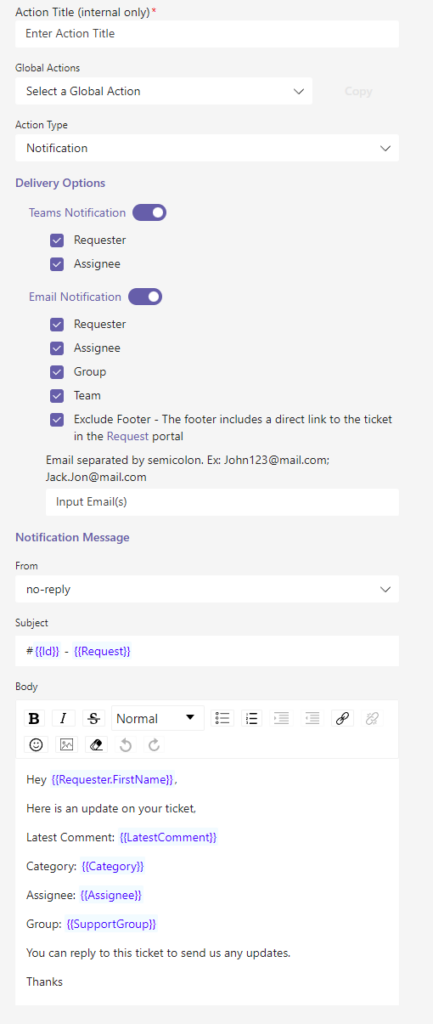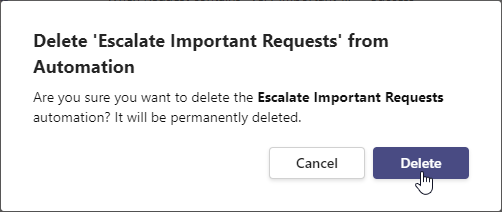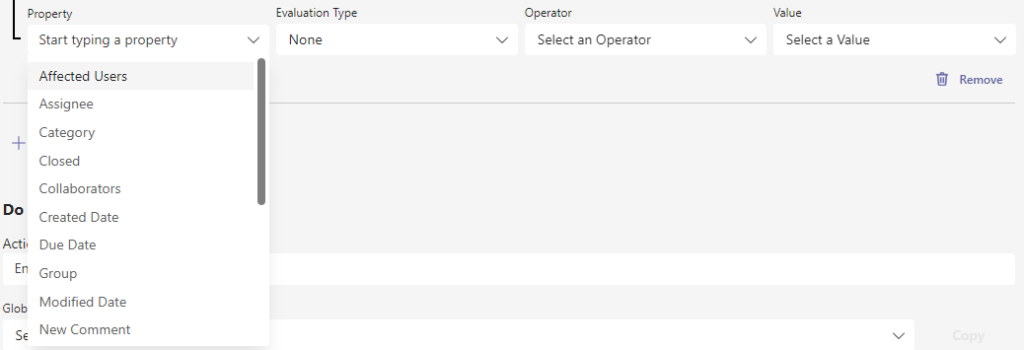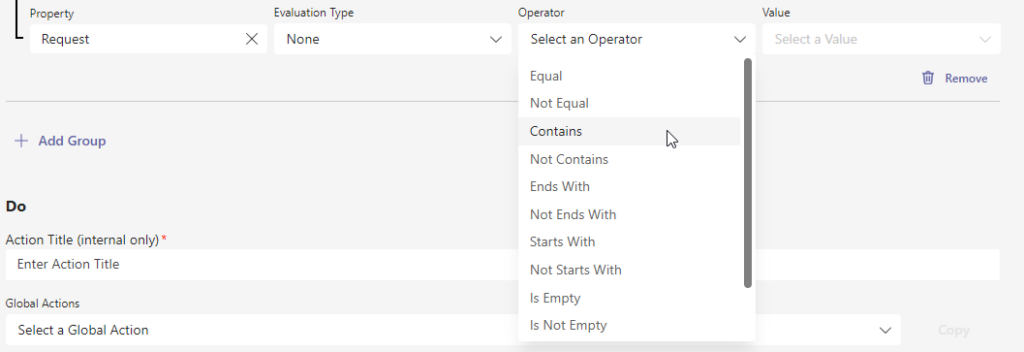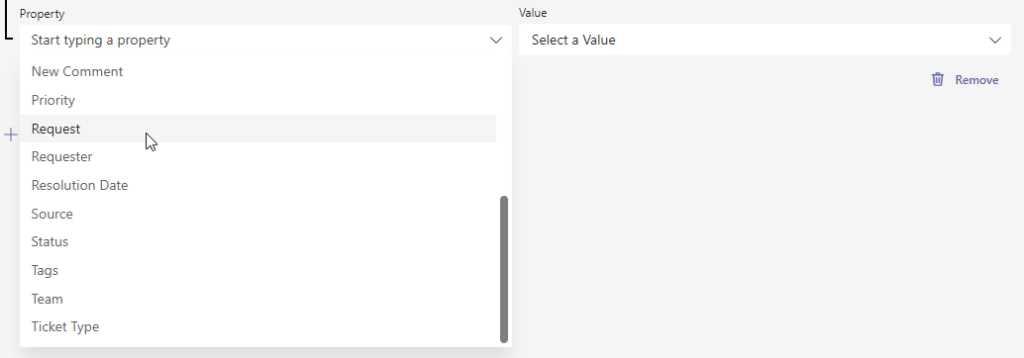Admins can create automation workflows to automatically update ticket properties. Automations support multiple triggers, including added, deleted, modified, and added & modified.
Analysts can view automations, but only administrators can update or create new automations. For details on managing app roles, see Assign users and groups to Application Roles.
To access and manage automations:
- Open the Tikit web app at https://web.tikit.ai.
- Once in the Tikit web app, select settings gear in the header, then select Automation.
- Hover over the labels or check out the following key section for more details.

- Success Completed successfully.
- Failed Did not complete successfully.
- Partial Success Automation was partially successful.
- New Automation Add a new automation.
- Search Search for automations by name, description, or status.
- Title Automation title. Select to view and update automation details.
- Description Automation description.
- Status The status of the automation based on its last run:
- Success Completed successfully.
- Failed Did not complete successfully.
- Partial Success Automation was partially successful.
- Enabled Enable/Disable an automation.
- Delete Delete an automation.
Need to prioritize a ticket based on the request or handle common tasks and improve workflows? Automations to the rescue with support for triggering automation on ticket creation, updates, and deleting to handle processes your way.
To add a new automation in the Tikit web app:
- Enter automation information in each section. Check out the Automation Form section below for more details.
- Select Save to save the new automation.
Processes can change and automations can change with them. Administrators can quickly enable/disable automations and update their triggers, filters, and actions.
To edit an existing automation:
- Update necessary automation information in each section. Check out the Automation Form section below for more details.
- Select Save to save any changes.
Retiring a process or tweaking your workflows and need to remove an automation? Don’t forget that automations can be disabled to avoid deleting them permanently, and then when the automation is needed again it can be quickly enabled. Otherwise, administrators can permanently delete automations.
To delete an automation:
The automation form has several sections to define when and how the automation should run:
-
- Information General automation settings like name, description, and if automation is enabled.
- When Determine when the automation should be run by choosing a trigger type.
- If Determine if an automation should run with a set of rules.
- Do Determine what the automation should do when run with a set of properties.
General information like Title, Description, and if the automation is Enabled can be found here.
- Hover over the labels or check out the following key section for more details.

- Title Title for automation.
- Description Description of automation.
- Enabled Enable/Disable automation. Disabled automations can still be updated, but will not run.
Determine when an automation runs. Automations run either by schedule or by event. Automations also support multiple ticket events: added, deleted, modified, and added & modified.
- Hover over the labels or check out the following key section for more details.

Toggle to trigger automation by schedule
1 of 2 2The frequency when the automation should run:
-
- Every Hour
- Every Day
- Every Week
- Every Month
- Every Year
- On a schedule Defines that automations will run on a schedule
- Trigger The frequency on when automation should run:
- Every Hour
- Every Day – runs daily at 00:00:00 UTC
- Every Week – every Sunday at 00:00:00 UTC
- Every Month – first day of the month at 00:00:00 UTC
- Every Year – first day of the year at 00:00:00 UTC

Toggle to trigger automation by an event
1 of 3 2 The type of entity to add automation to. The default and only value currently is Ticket. 2 of 3 3 The event that triggers, or starts, the automation:-
- Added A new ticket has been created.
- Deleted A ticket has been deleted.
- Modified A ticket has been modified.
- Added & Modified A ticket has been either created or modified. Great for avoiding managing two separate automations for Added and Modified events.
- On an Event Defines that automations will run based on an event
- Entity Name The type of entity to add automation to. The default and only value currently is Ticket.
- Trigger Type The event that triggers, or starts, the automation:
- Added A new ticket has been created.
- Deleted A ticket has been deleted.
- Modified A ticket has been modified.
- Added & Modified A ticket has been either created or modified. Great for avoiding managing two separate automations for Added and Modified events.
Determine if an automation should run. The filtering rules are defined based on the properties of the ticket triggering the automation. Rules are categorized into groups of filters. All groups must evaluate to true to continue to the Do section while the filters within each group can be evaluated with AND(&&) or OR(||) logic by selecting the AND|OR switch in the top left of the group.
- Hover over the the table labels or check out the following key section for more details.

- AND All filters in the group must be true.
- OR At at least one filter in the group must be true.
Choose a Property to evaluate, an Operator for the type of comparison, and a Value compare with. 5 of 7 6 Remove a filter from the group. 6 of 7 7 Add a new group of filters to the rule. All groups must pass for an automation to continue. 7 of 7
- Rule Title Title of the rule.
- Global Rules Select and copy a rule template from a set of predefined rules.
- Logical Operator (AND|OR) Toggle between AND (&&) and OR (||) when evaluating the group’s filters:
- AND All filters in the group must be true.
- OR At at least one filter in the group must be true.
- Add Filter Add a new filter to a group.
- Property Filter Filter based on the properties of the Ticket triggering the automation. Choose a Property to evaluate, an Operator for the type of comparison, and a Value compare with.
- Delete Filter Remove a filter from the group.
- Add Group Add a new group of filters to the rule. All groups must pass for an automation to continue.
Rules can contain multiple groups working together for advanced logic. Selecting Add Group will add a new group at the bottom of the rule. Any added groups can also be removed by selecting the delete icon to the right of each added group.
To add a group:
Each group can contain multiple filters. Selecting Add Filter will add a new property filter to a group. For more on the different property types see the section below on
To add a filter to a group:
- Select an Operator.
The Operator and Value fields are based on the data type of the selected Property. Properties can be Strings, True/False (Boolean), and Dates. See the following sections on each type for details.
- In the Value field, enter a value to compare with the Property using the Operator. Some Operators like Is Null do not require a value to be entered.
For example, Title Contains Printer will look for “Printer” anywhere in the Title string like “The Printer is out of ink”, while Ticket Starts With Printer will match strings starting with “Printer” like “Printer is out of ink”.
Strings include fields like Request.
String Operators
- Equal
- Not Equal
- Contains
- Not Contains
- End With
- Not Ends With
- Starts With
- Not Starts With
- Is Empty
- Not Is Empty
- Is Null
- Is Not Null
Value is a string (e.g., “Printer”, “Product Key”, “Network”, etc.).
Note that some operators like the “Is Null” and “Is Not Null” operators do not require a value to be set.
Date properties represent dates and include fields like Ticket Due Date and Resolution Date. The filter values for these properties support either specific Values like ’12/1/2021′ or Relative Dates like Today, # Days Ago, and # Days from Now.
DateTime Operators
- Earlier Than
- Earlier Than or Equal to
- Later Than
- Later Than or Equal to
- Is Null
- Is Not Null
Value is a date. Specific dates can be entered manually or by using the date pickers by selecting the calendar button. Relative Dates are dynamic and can be selected from a dropdown. Several Relative Dates like # Days Ago have additional number input with spinner buttons to increase or decrease the number of Days, Months, Years, etc..
Note that the “Is Null” and “Is Not Null” operators do not require a value to be set.
Boolean properties have a value of either True or False and include fields like Closed.
True/False (Boolean) Operators
- Equal
- Not Equal
- Is Null
- Is Not Null
Value is either True or False. Values are selected from a dropdown. If no value is selected, leaving the Value field blank, then the property’s value will be Null. The “Is Null” and “Is Not Null” operators would be used in that case.
Note that the “Is Null” and “Is Not Null” operators do not require a value to be set.
The Do section is where the action is. This section determines what Properties should be updated by the automation.
For example, setting Resolution Date automatically when tickets are resolved or setting the Assignee for a ticket to an Analyst based on category.
- Hover over the the table labels or check out the following key section for more details.

- Create Create a new ticket.
- Update Update the properties of the Ticket or User that triggered the automation.
- Action Title Title to describe the action.
- Global Actions Select and copy an action template from a predefined list.
- Action Type What type of action the automation should perform:
- Create Create a new ticket.
- Update Update the properties of the Ticket that triggered the automation.
- Notification Sends a teams and/or email notification to the requester and/or assignee of the ticket that triggered the automation
- Property Property to update.
- Add Property Add a new property to update.
Picking an Action Type depends on what you would like your automation to do:
- Create Create a new ticket, using the action’s properties to set its values.
- Update Update the ticket that triggered the automation, using the action’s properties to update its values.
- Notification Sends a teams and/or email notification to the requester and/or assignee of the ticket that triggered the automation.
- Select a ticket Property. After selecting the Property, the Value field will be enabled.
The Value field is based on the data type of the selected Property. Properties can be Strings, True/False (Boolean), and Dates. See the following sections on each type for details.
Strings include fields like Title, Description, and Name.
Value is a string value like “Printer”.
Dates include fields like Due Date and Resolution Date. These properties support either specific Values like ‘1/1/2024 12:00 AM’ or Relative Dates like Today, # Days Ago, and # Days from Now.
Value is a Date. Specific Dates can be entered manually or using the date picker by clicking the calendar button. Relative Dates are dynamic and can be chosen from a dropdown. Some Relative Dates like # Days Ago have additional number input and spinner buttons to increase or decrease the number of Days, Months, Years, etc..
Boolean properties have a value of either True or False and include fields like Closed and IsDeleted.
Value is either True or False based on a dropdown selection.
- Select Notification from Action Type
- To send notification via teams, toggle on Teams Notification switch.
- Under Teams Notification, select the appropriate recipient by ticking the checkbox.
- To send notification via email, toggle on Email Notification switch
- Under Email Notification, select the appropriate recipient by ticking the checkbox.
- Under the From field, you can choose to send notifications from Tikit’s No Reply or the Inbox you configured in the Email Connector.
- Fill in the Notification Subject and Message box
- The Subject and Body of Email notifications can use variables from the Ticket. To use a variable, begin typing { to see a list of options.
- The Email Connector processes updates to tickets by looking for #Id in the Subject. e.g. #5731.
